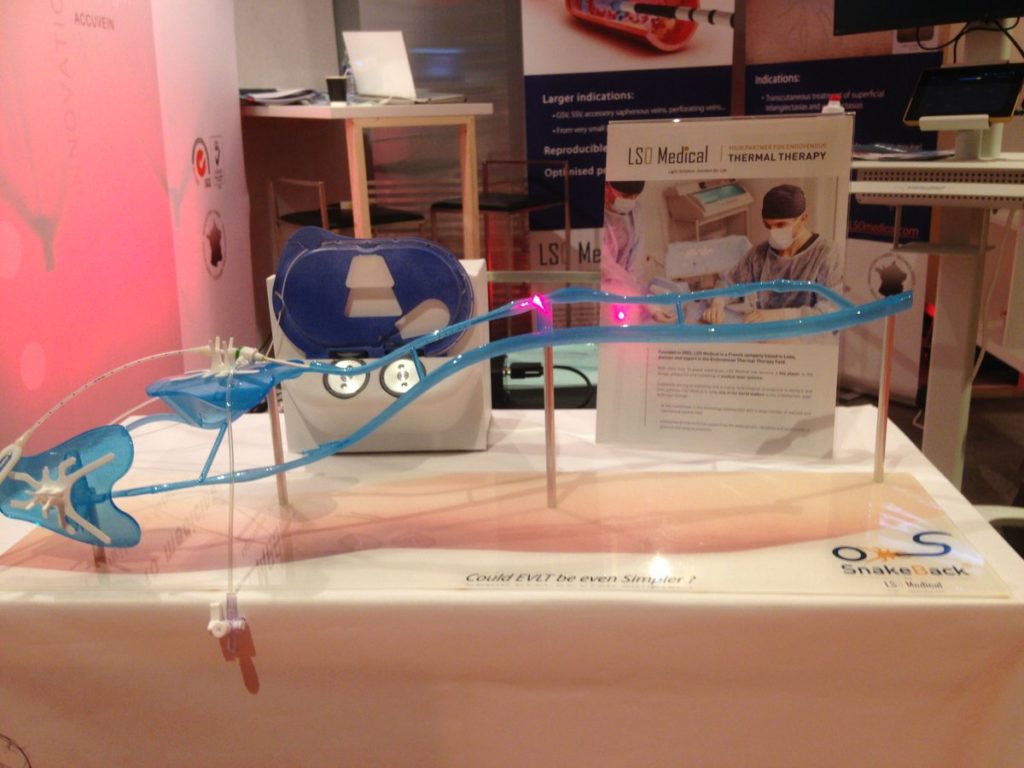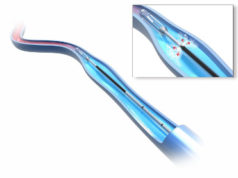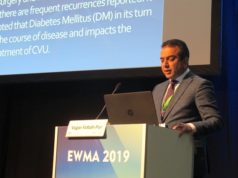 A first prototype of a novel endovenous therapy technology (SnakeBack, LSO Medical) integrated with a laser ablation platform was revealed earlier this year at the Charing Cross Symposium (CX; 24-27 April, London, UK) by Philippe Rochon, president of LSO Medical, Nord, France.
A first prototype of a novel endovenous therapy technology (SnakeBack, LSO Medical) integrated with a laser ablation platform was revealed earlier this year at the Charing Cross Symposium (CX; 24-27 April, London, UK) by Philippe Rochon, president of LSO Medical, Nord, France.
The SnakeBack is a remote catheter removal system that works automatically, without the need for fibre tension or alignment. A long, fitted sheath is attached to the patient’s leg and to the system. The SnakeBack slides the fibre inside the sheath and continues into the vein, adjusting the position of the fibre. An additional step involves plugging the sheath on both the patch and the SnakeBack system, installing a cassette, and activating the system to begin an automatic withdrawal.
The SnakeBack aims to minimise human error—an important factor, Rochon noted, with regards to overcoming the current limitations of endovenous pull-back systems. These limitations include difficulty installing both the device and fibre, issues trying to achieve a leg-fibre-device alignment, and the need for constant fibre tension.
Over the years, several endovenous techniques have been developed for the treatment of varicose veins. Energy-based techniques such as laser, radio frequency or steam ablation rely on delivering doses linearly and consistently along the vein. Chemically-based techniques such as cyanoacrylate or chemico-mechanical based techniques such as MOCA have been similarly used as treatment strategy options.
Rochon noted that for adequate results, physicians need to have either a good positioning of the catheter inside the vein, or good control of the velocity of the catheter. Once these factors can be guaranteed, dose delivery can occur consistently along the vein, subsequently resulting in efficient and safe treatment.
In view to evolving the technology, Rochon and his team made several observations, many of which involved their concerns regarding the variability of dose delivery. To test these concerns, they carried out a simple test in which 28 physicians were asked to perform a laser shot in phantom, aiming to deliver 50J/cm of energy over a 20cm linear distance. During this process, the speed of the catheter was recorded to examine the difference between the target and the actual delivery distance. Results of this test confirmed their concerns, Rochon said, as the data showed significant deviations from the target and the average dose delivery was highly variable.
However, Rochon noted that the simple study was carried out in 2008, and since, techniques have improved. For example, the industry has proposed various approaches to develop linear dose delivery, with an emphasis on control over either the positioning of the catheter or the velocity handling. Subsequently, methods today involve markings on the catheter (as used in laser and radio frequency ablation as well as MOCA), sound signals to synchronise the movement of the catheter, or automatic pull-back devices.
The second observation that Rochon and his team made involves the nature of these procedures. With many doctors carrying out 500 laser procedures a year, of which the average vein length to treat is 30cm, the total treated distance is 15,000cm per year. Rochon explained how the tedious nature of the procedure—coupled with a large number of repetitive handlings—is likely to lead to attention loss, suggesting a high risk of mistakes occurring. The SnakeBack technology aims to eliminate this human error, reducing the risk for future procedures.
The Snakeback technology has been integrated on a laser ablation platform. Rochon’s company, LSO Medical, is working on a clinical evaluation protocol in view to understanding the potential drawbacks of this technique, whilst evaluating other clinical applications and scope of the technology in other treatment modalities. Regardless, the system offers an interesting solution to solving the problem of non-uniformity of laser withdrawal rates, specifically in patients who recanalise from inadequate ablation and patients who have pain from too much treatment in one location.









